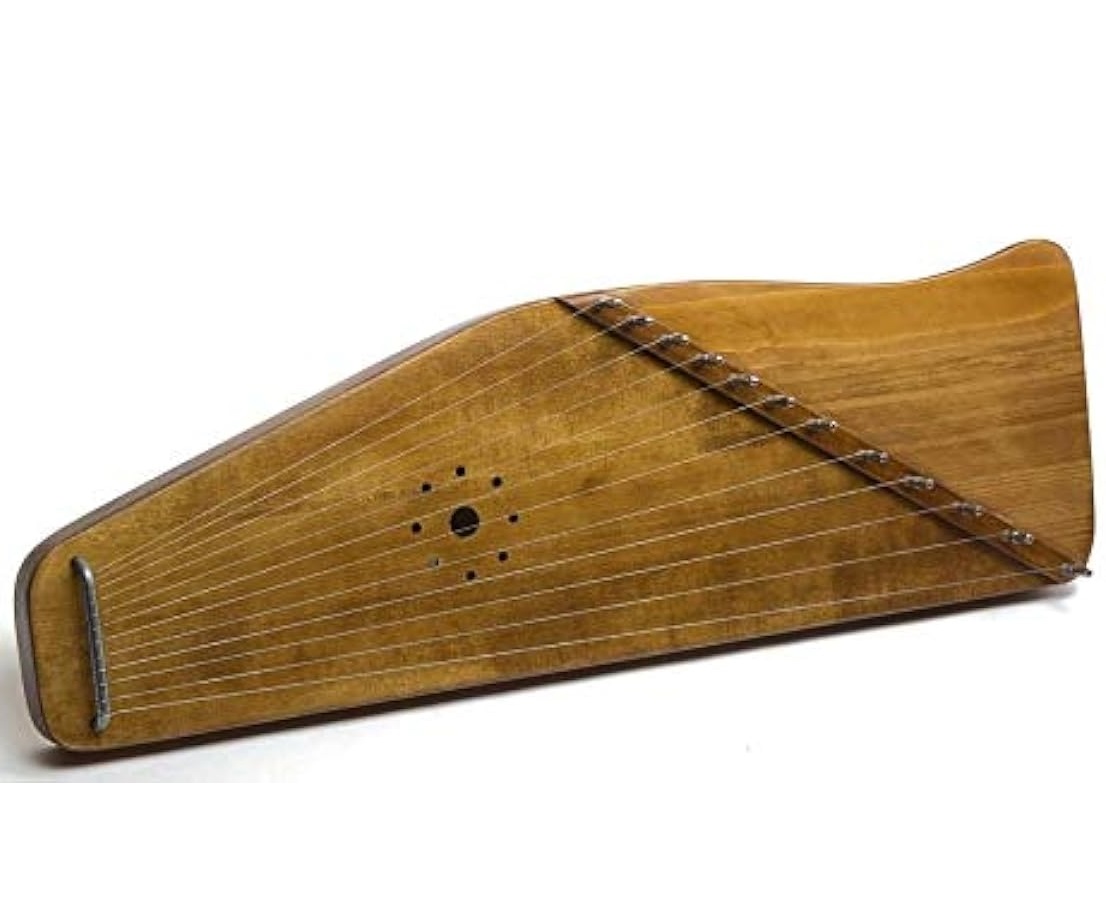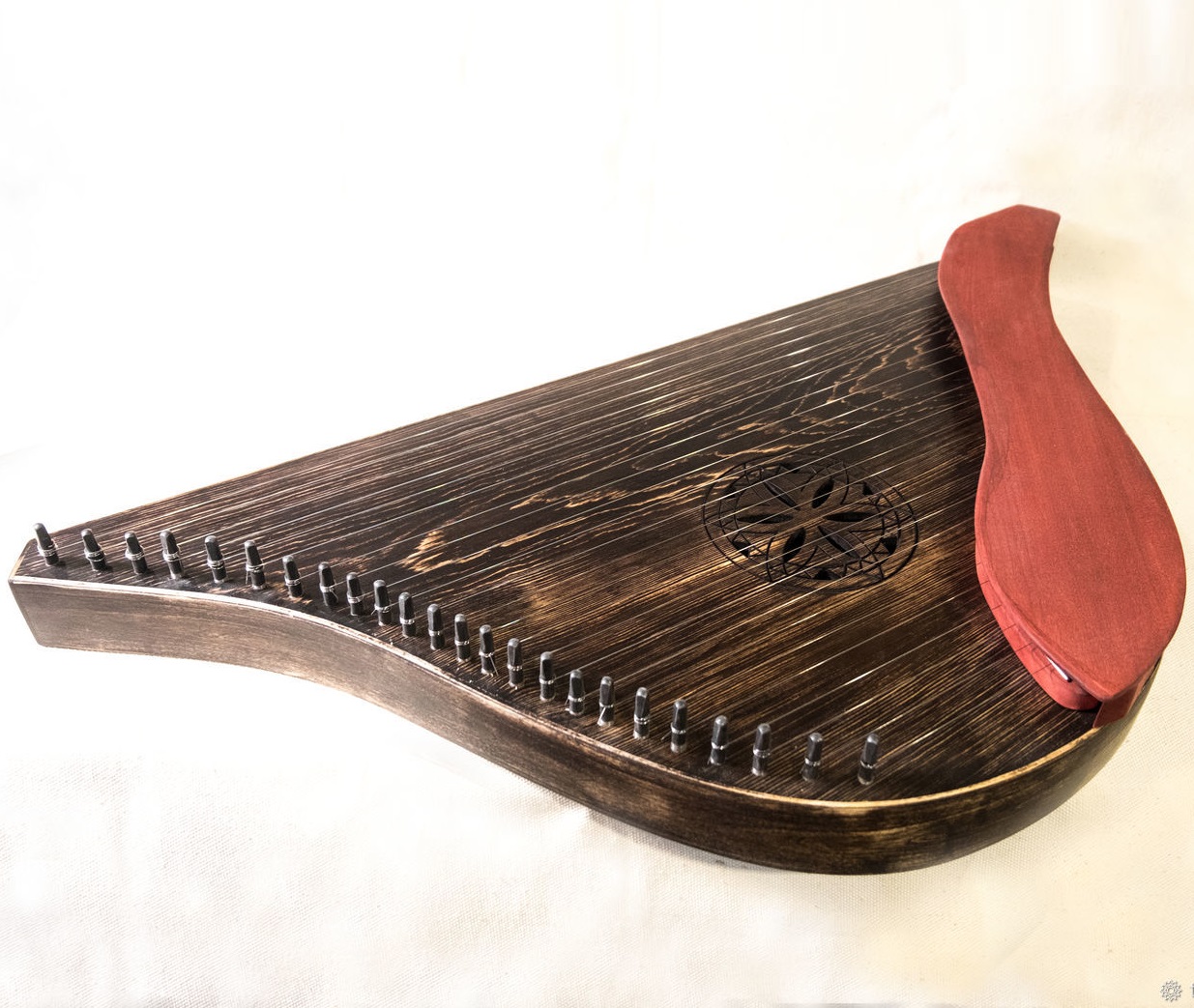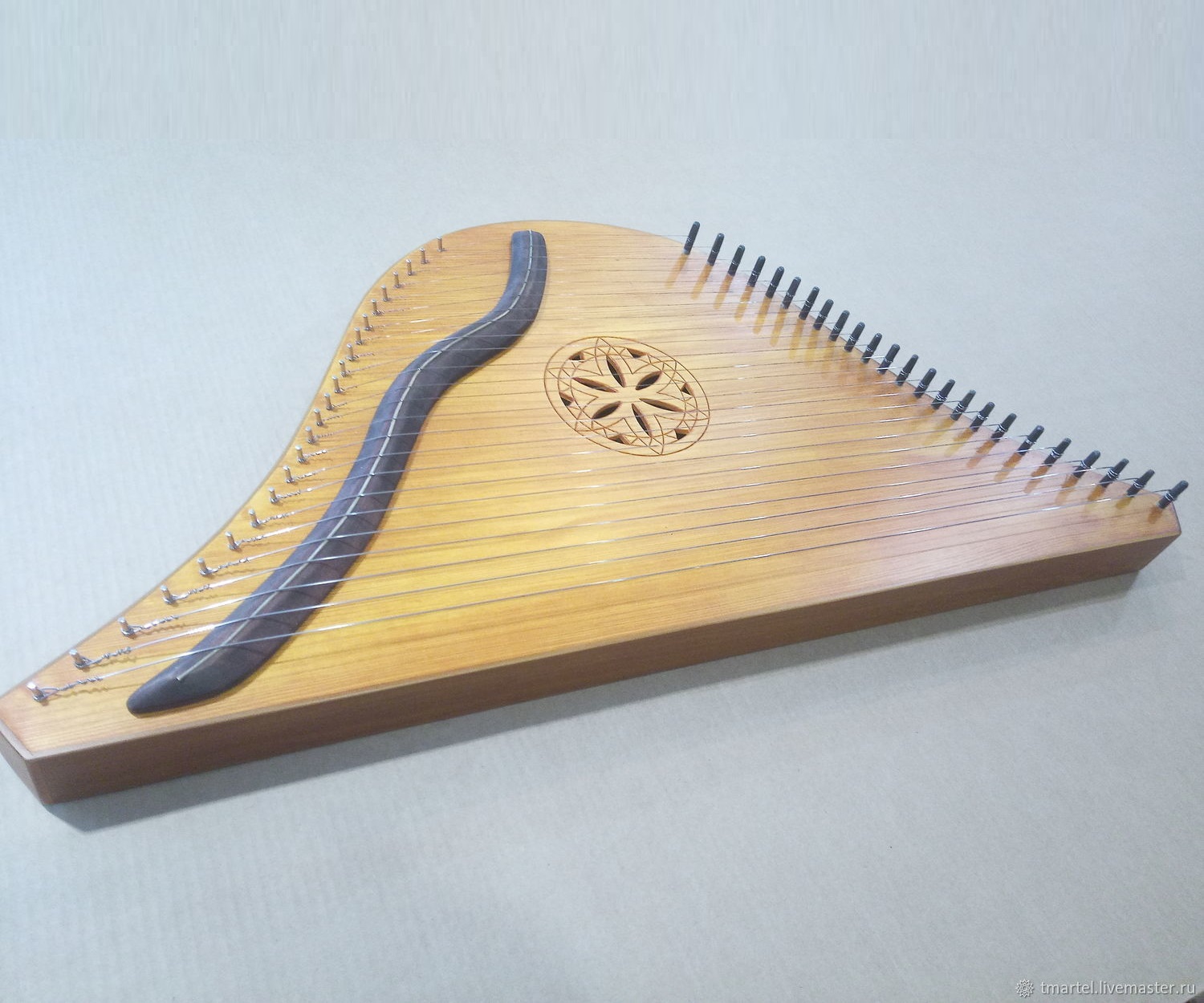Gusli
Plucked Instruments
Europe
Between 0 and 1000 AD
Video
The gusli, a multi-stringed plucked zither, stands as a cornerstone of Russian folk music, its melodies weaving tales of ancient heroes, epic battles, and the serene beauty of the Russian landscape. This instrument, deeply embedded in the cultural fabric of Russia, offers a window into the nation’s rich history and enduring traditions.
Description and Type of Instrument
The gusli is a chordophone, specifically a plucked zither. It consists of a soundboard over which strings are stretched, typically made of metal or gut. The strings are plucked with the fingers or a plectrum, producing a bright, clear sound. The instrument’s body acts as a resonator, amplifying the vibrations of the strings. The gusli’s design varies depending on its type and regional variations, but the fundamental principle of a soundboard and stretched strings remains consistent. Its sound, often described as ethereal and evocative, has made it a central instrument in Russian folk ensembles and storytelling traditions. The gusli’s ability to create both melodic and harmonic textures contributes to its versatility and enduring popularity.
History and Origin
The origins of the gusli can be traced back to the Slavic tribes inhabiting Eastern Europe, particularly in the territory that would eventually become Russia. Archaeological findings and historical records suggest that the instrument has existed since at least the 6th century AD. The earliest forms of the gusli were likely simpler, with fewer strings and more rudimentary construction. Over the centuries, the instrument evolved, influenced by cultural exchanges and technological advancements. During the Kievan Rus’ period (9th-13th centuries), the gusli gained prominence in courtly and folk music, becoming associated with epic poems (byliny) and storytelling. The instrument’s popularity continued throughout the medieval and early modern periods, with regional variations emerging and new playing techniques being developed. The gusli’s role in Russian culture was not limited to entertainment; it also served as a tool for preserving and transmitting oral traditions, connecting generations through music and storytelling. By the 19th and 20th centuries, the gusli experienced a revival of interest, with efforts to preserve and promote its traditional forms and playing styles. The instrument’s enduring presence in Russian folk music and its continued evolution reflect its deep connection to the nation’s cultural heritage.
Construction and Design
The construction of the gusli involves several key components, each contributing to the instrument’s unique sound and aesthetic. The soundboard, typically made of spruce or other resonant wood, forms the top of the instrument’s body. The strings, ranging in number from a few to several dozen, are stretched across the soundboard, anchored at one end by a tailpiece and at the other by tuning pegs. The body of the gusli, which can be flat, boat-shaped, or wing-shaped, acts as a resonator, amplifying the vibrations of the strings. The materials used in construction vary depending on the type of gusli and the region of origin, but traditional instruments often feature high-quality woods and meticulous craftsmanship. The design of the gusli often incorporates decorative elements, such as intricate carvings, inlays, and painted motifs, reflecting the cultural and artistic traditions of the region. The shape of the gusli also plays a role in its sound production, with different body shapes producing distinct tonal qualities. The tuning pegs, typically made of wood or metal, allow for precise adjustment of the string tension, enabling the player to achieve the desired pitch. The bridge, which supports the strings on the soundboard, also contributes to the instrument’s sound, influencing the string’s vibration and tonal characteristics.
Types of Gusli
The gusli family encompasses several distinct types, each with its own characteristics, playing techniques, and historical significance.
Wing-Shaped Gusli (Krylovidnye gusli): This type is characterized by its distinctive wing-like shape, resembling a bird in flight. It often features a large number of strings, allowing for complex harmonies and melodic textures. The wing-shaped gusli is commonly used in concert performances and large folk ensembles.
Helmet-Shaped Gusli (Shlemovidnye gusli): As the name suggests, this type has a helmet-shaped body, which contributes to its resonant and powerful sound. The helmet-shaped gusli is often associated with epic poems and storytelling, its robust tone reflecting the grandeur of the narratives.
Table Gusli (Stolovidnye gusli): This type is designed to be played while resting on a table or other flat surface. It often features a smaller number of strings than the wing-shaped gusli and is commonly used in folk music ensembles and for solo performances.
Lyre-Shaped Gusli (Lirovidnye gusli): These Gusli are shaped to look like a lyre. They show the influence of western European lyre styles. These are some of the more modernized versions of the instrument.
Clavi-Gusli: This modernized version of the instrument combines the Gusli with a keyboard allowing for a broader range of music to be played. These variations in design and construction reflect the regional diversity and evolving musical practices within Russia. Each type of gusli possesses its own unique voice, contributing to the rich tapestry of Russian folk music.
Characteristics
The gusli’s characteristics stem from its unique construction and playing techniques, resulting in a distinct sound and musical expression. The instrument’s clear, bright tone, often described as ethereal and evocative, is a hallmark of its sound. The strings, typically made of metal or gut, produce a resonant vibration when plucked, creating a rich harmonic texture. The gusli’s ability to create both melodic and harmonic patterns allows for a wide range of musical expression, from simple folk melodies to complex concert pieces. The instrument’s versatility extends to its adaptability to different musical contexts, from solo performances to ensemble playing. The gusli’s sound is deeply connected to the Russian cultural landscape, evoking images of vast landscapes, ancient forests, and flowing rivers. The instrument’s association with epic poems and storytelling has imbued it with a sense of historical significance, connecting listeners to the traditions and legends of the past. The techniques used in gusli playing also add to its characteristic sound. Vibrato, arpeggios, and various rhythmic patterns are all used to create expressive musical passages. The gusli’s ability to produce both delicate and powerful sounds contributes to its emotional range, allowing it to convey a wide spectrum of feelings. The instrument’s enduring popularity and continued evolution reflect its enduring appeal and its ability to adapt to changing musical tastes. Its role as a cultural symbol and its musical versatility have ensured its place in the hearts of Russians and music lovers around the world.
Playing Techniques and Sound Modifications
The gusli’s playing techniques vary depending on the specific type of instrument. Historically, the “helmet-shaped” (shlemovidnye) gusli were played by placing the instrument on the knees, with the left hand muting unwanted strings to form chords, while the right hand strummed across all the strings. The “wing-shaped” (krylovidnye) gusli, smaller and more akin to Baltic psalteries, are often held more like a modern guitar, with the left hand muting strings through a specific opening in the instrument’s body. Modern gusli players utilize a range of techniques, including:
Strumming: This is the most fundamental technique, producing chords and rhythmic patterns. Variations in strumming speed and intensity create dynamic changes in the music.
Plucking: Individual strings can be plucked to create melodic lines, arpeggios, and intricate patterns.
Muting: The left hand plays a crucial role in muting strings, allowing for the creation of clear chords and preventing unwanted resonances.
Harmonics: Skilled players can produce harmonics by lightly touching the strings at specific points, creating ethereal and bell-like tones.
Sound modifications come from the materials used in the construction of the instrument, and also from the way the player uses their hands. The type of strings, the wood that the gusli is made from, all change the overall tone of the instrument.
Applications in Music
The gusli’s versatility has made it a staple of Russian folk music for centuries, and it continues to find applications in a variety of musical genres. In traditional Russian folk music, the gusli is often used to accompany singers and dancers, providing a rhythmic and melodic foundation for performances. It plays a central role in epic storytelling, where its evocative sound enhances the narrative and transports listeners to the world of ancient heroes and legends. The gusli is also used in religious ceremonies, particularly within the Old Believer tradition, where its sound is considered to have spiritual significance. In contemporary music, the gusli has found a place in various genres, from folk-rock to experimental compositions. Modern composers and performers are exploring the instrument’s sonic potential, incorporating it into new musical contexts and blending it with other instruments. The gusli’s unique sound has also been featured in film scores and theatrical productions, where its evocative timbre adds depth and atmosphere to the narrative. Its use in educational settings is also growing, as educators recognize its value in teaching students about Russian culture and music history. The gusli serves as a powerful tool for cultural preservation, ensuring that the traditions and stories of the past are passed down to future generations. The instrument’s presence in contemporary musical expressions also ensures that it remains a living, evolving part of Russian cultural life.
Most Influential Players
Identifying the “most influential” gusli players across centuries can be challenging, given the oral traditions that dominated much of its early history. However, some key figures and trends stand out:
Skomorokhi: These wandering musicians played a crucial role in preserving and transmitting gusli traditions. Their performances, often combining music, storytelling, and dance, shaped the instrument’s cultural significance.
Contemporary Performers: Modern gusli players, such as Kirill Bogomilov, are revitalizing the instrument’s popularity and exploring its potential in new musical contexts. These musicians are expanding the gusli’s repertoire and introducing it to wider audiences.
The work of Sergey Gorchakov, who has worked to produce gusli in modern times, has also been very influential in keeping the instrument alive. These modern players are helping to keep the ancient instrument alive, and are also working to create new and exciting music with it.
Maintenance and Care
Like any musical instrument, the gusli requires proper maintenance and care to ensure its longevity and optimal performance. The instrument’s wooden body is susceptible to changes in temperature and humidity, which can cause warping or cracking. To prevent damage, it is essential to store the gusli in a stable environment, away from direct sunlight and extreme temperature fluctuations. A humidifier can be used to maintain a consistent humidity level, especially in dry climates. The strings of the gusli should be regularly inspected for wear and tear, and replaced as needed. Metal strings can corrode over time, while gut strings can become brittle and break. The bridge and nut, which support the strings, should also be checked for damage or wear. Regular cleaning is essential to remove dust and dirt from the instrument’s body and strings. A soft cloth can be used to wipe down the instrument after each use. For more thorough cleaning, a specialized instrument polish can be used. The tuning pegs should be lubricated periodically to ensure smooth and accurate tuning. If the gusli requires repairs or adjustments, it is best to seek the services of a qualified luthier or instrument repair technician. They have the expertise and tools to address any issues and ensure that the instrument is in optimal playing condition. Proper maintenance and care will not only prolong the life of the gusli but also enhance its sound and playability, allowing it to continue to resonate with its rich cultural heritage.
Cultural Significance
The gusli’s cultural significance in Russia is profound and multifaceted, reflecting the instrument’s deep roots in the nation’s history and folklore. It is more than just a musical instrument; it is a symbol of Russian identity, a vessel for cultural memory, and a conduit for spiritual expression. The gusli’s presence in epic tales and byliny has cemented its association with Russian heroism and national pride. Its sound evokes images of ancient warriors, wise sages, and mystical landscapes, connecting listeners to the rich tapestry of Russian mythology. The instrument’s role in traditional celebrations and ceremonies underscores its importance in Russian social life. It is often played at weddings, festivals, and other communal gatherings, where its music fosters a sense of unity and shared heritage. The gusli’s connection to religious traditions, particularly within the Old Believer community, further highlights its spiritual significance. Its sound is believed to possess healing properties and to facilitate communication with the divine. The gusli’s enduring popularity in contemporary music and cultural events testifies to its continued relevance in modern Russian society.
It serves as a bridge between the past and present, ensuring that the traditions and stories of the past are passed down to future generations. The instrument’s presence in educational settings also underscores its importance in preserving and promoting Russian cultural heritage. By teaching students about the gusli and its history, educators are fostering a deeper understanding and appreciation of Russian culture. The gusli’s cultural significance extends beyond Russia’s borders, as it has become a symbol of Russian folk music and cultural identity worldwide. Its unique sound and rich history have captivated audiences around the globe, contributing to the appreciation of Russian culture on an international scale. The gusli stands as a testament to the enduring power of music to connect people to their cultural roots and to transcend geographical boundaries.
FAQ
What is the history and origin of the Gusli?
The Gusli is one of Russia's oldest stringed instruments, dating back to the 9th century. It is believed to have been influenced by Byzantine and East Slavic cultures. It played a key role in folklore and court music, often associated with skomorokhs (wandering musicians). Over centuries, it evolved into different forms, retaining its cultural significance.
What materials are used to construct the Gusli?
Traditional Gusli are crafted from solid wood, typically spruce or maple, for the soundboard. The strings are made of metal or gut, producing distinct tonal qualities. Some modern versions use synthetic materials for durability. The instrument’s frame is carefully shaped to enhance resonance and sustain.
What are the types and features of the Gusli?
The main types of Gusli include the Wing-shaped (played on the lap), Helmet-shaped (used in ensembles), and Keyboard Gusli. They vary in string numbers, typically ranging from 5 to over 30. The instrument produces a bright, harp-like sound and is played by plucking or strumming the strings with fingers or a plectrum.
 Links
Links
References
Other Instrument
Categories




















